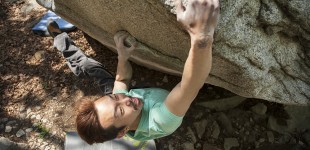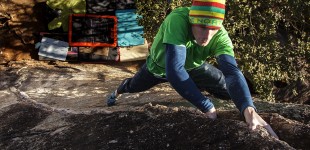Go Climb Something!!!
No matter where the journey takes you, do not forget your camera and climbing shoes.
Latest
Life On The Move
Question Answered: Mileage is the Key
Eddie
Do you know a good forearm regiment for climbing conditioning?
Sam
Sam
Thanks for the question Sam. I want to start off by letting you know that I am just a rock climber. My understanding of anatomy and physiology is very rudimentary and limited. I am not an expert by any means. Saying that I would love to go over some of the exercise that I use to maintain and push my forearm strength, endurance, and power endurance.
The first thing that I can say is you need to be climbing to establish a base level of forearm fitness. This means at least two days a week at the climbing/bouldering gym working out. This is usually time not spent climbing your project or really having “fun”, but rather climbing for mileage and a purpose. If you are at your local climbing establishment Slidell Rocks, then climb up-down-ups. Try not to worry very much about staying on route. Focus on smooth, calculated movements. Take planned rests and once you have planted your foot once do not move it until you make a new move. I would recommend trying this on about 10 routes. In essence climbing about 900 ft at SR. Remember you are going for mileage so on these work out sessions do not climb routes at the cusp of your ability. Rather just under your ability is best. If you find that 10 up-down-ups are too easy increase the level of difficulty on the last three and climb to a point of failure on the last two. I would also suggest that once you are on route three through 8(out of 10) to add some three second counts on holds. While you are in a holding stance/position, move into position to make your next movement and remove the hand that will be making that movement and count to three before making contact with that next hold. Forcing yourself to make lock-offs mid-route is both good practice and a work out. Muscle memory plays a large part in climbing so, the more you climb the more familiar your body will be to the climbing movements.
If this does not sound good to you try the bouldering side of the gym. Sill climbing for mileage, warmup well on a flat, non over hung wall first, then rest for three or four minutes. Then on the 45 make as many moves as you can with out leaving the wall. Again these moves do not need to be very hard. This exercise is best if you keep your feet on the wall at all times. No all-points off throws are required for this exercise. Climb until failure. I would recommend to do this exercise four times with five minute rests in between. Stay hydrated.
Another exercise that you can do on the 45 is lock offs. I use this routine at least twice a week. There are several different techniques to this exercise. I will recommend three. First is the uneven lock-off hang. With your high hand on a larger hold and your lower hold around a foot lower on a smaller hold, pull up to where your top hand is at a 90 degree angle. Dangle feet and hold until failure. Do three hangs on each arm, rotating arms after each hang. The next is the cross body tension lock-off exercise. To make it easier to explain start with your right hand on a good hold high, nothing crimpy, and your left foot on the wall. Flag your right leg and left arm to the side and lock off your right arm in the 90 degree position again. Do this until failure. Three sets and lock-offs per arm is best. The last is the uneven hang high-step. In the same position as the uneven hang, proceed to move leg on the lower arm’s side to a low hold, then middle level hold, then hold near your high hand. The foot action should be that you are hanging free in the air and you swing your leg to a low hold on the wall. Then drop the leg back down and then proceed to swing your leg to the middle level foot hold. Again drop your leg down and swing your leg up to the top foot hold near your hand. Drop the leg down again to finish one leg (left or right) set. Switch hands, from right high left low to left high right low, and continue with another set. I would do three sets on each leg.
Always remember to tape your fingers when you are doing a finger intense workout. Examples of these are the hang board, campus rungs, mileage on a 45, or any other long workout that involves crimping closed hand for long periods of time. I suggest to use the cross taping technique. Taping your fingers this way ensures that your entire finger pulley system is encompassed. Which will help in reducing the amount of finger injuries.
Weights are a nice addition to this regimen. Using free weights in my opinion have proven to be the best for my body because they allow me to move freely. Using machines is not bad per say, but machines really restrict the body’s natural movements. I prefer free weights when possible. Remember that we are only talking about forearms today, but there are several other considerations when it comes to weight training. Your complimentary muscles and muscle hypertrophy should be considered. Spending so much time just climbing actually builds some muscles and we loose strength in others. In weight lifting you should do a complete upper body work out. Also make sure that a weight lifting day is considered a climbing day. Two required days of climbing with one of those days spent climbing and the other on weights is OK. My general upper body work out routine is incline, bench press, curls, dips, the medicine ball Rocky Solo, pull-ups, and push-ups. I usually do about 50% of max in weight and 5 to 6 sets of 10 reps. The key for you will be to determine your max and establish your own workout that suits your level and body type.
Maintaining an overall body fitness is just as important and should not be overlooked. Swimming, biking, and running are THE best ways to achieve this. Biking for at least an hour in the hills/mountains longer on flats, running at least 5 miles, and swimming 50 laps is not for everyone, but great! Start with a 3 mile run, a 12 lap swim, or a 35 mile bike ride. Choose one of these and see where you stand and adjust to your current fitness. This form of exercise has many benefits. The two biggest benefits are that you will train your body to deal with lactic acidosis and weight control. Like I said there are MANY benefits, but for our topic today these are the two points of significance. Training your body to become accustomed to lactic acidosis is a very important in any endurance training. Once your body in familiar with this process your body will process LA faster and move efficiently. In turn, lowering the amount of rest time required to recover on a route. And making for a send-tastic day!!
I hope this helps. Let me know of your progress and any changes to this format that you found helped you attain your goals.
Here are a few reference books that I have used over the years in this topic:
Extreme Alpinism by Mark Twight
Climbing Stronger, Faster, Healthier: Beyond the Basics by Michael Layton
The Rock Warrior’s Way: Mental Training for Climbers by Arno Ilgner
How to Climb 5.12 by Eric Horst
One Move Too Many by Dr. Volker Schöffl and Sam Lightner Jr.
Thanks,
Eddie
Go Climb Something!!!!









